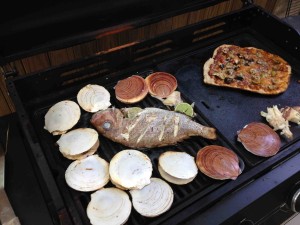Queensland has fabulous limes.
They taste nothing like the American ones, and I buy them by the bucket.
I’m a late arrival to the virtues of limes – odd that I have Limey heritage – but now they are in everything: the gallons of fruity herbal tea I drink daily, water  with ice and lemon-lime-ginger bitters, lime butter for popcorn and seafood, you get the idea.
with ice and lemon-lime-ginger bitters, lime butter for popcorn and seafood, you get the idea.
I have a Tahitian lime tree on my concrete balcony, with dreams of someday moving near the ocean and properly planting my tree.
A boy can dream.
The acid in limes has long been used to marinate or cook raw fish in ceviche. But does it really make seafood safe?
Prateek Mathurand and friend of barfblog, Don Schaffner, report in this month’s Journal of Food Protection that lime juice does reduce levels of Vibrio, but is not so effective against Salmonella. I’ll stick with lime and a mild heat treatment for any seafood. Raw is risky.
Journal of Food Protection, Number 6, June 2013, pp. 928-1108 , pp. 1027-1030(4)
Mathurand, Prateek; Schaffner, Donald W.
Abstract:
Ceviche is a raw fish dish common in Peru and other Latin American counties. The most characteristic feature of ceviche is the use of lime juice for marinating or “cooking” the raw fish. Confirmed cases of cholera in Peru, New Jersey, and Florida have been associated with ceviche. Although the effect of organic acids on pathogenic bacteria has been well characterized, few data exist on the effect of these acids in seafood systems. The objective of the study was to evaluate the effects of lime juice marination on pathogens likely to be present in ceviche. Tilapia (Oreochromis niloticus) fillet pieces were inoculated with Vibrio parahaemolyticus and Salmonella enterica (>7 log CFU/g) and  incubated at 25 and 4°C for 30 or 120 min in the presence of fresh lime juice at concentrations typical for the preparation of ceviche. Similar levels of cells were also inoculated into fresh lime juice without tilapia. Surviving cells were enumerated on selective (xylose lysine Tergitol 4 and thiosulfate-bile-citrate-sucrose) and nonselective (tryptic soy agar) media. V. parahaemolyticus levels were reduced to below detection limits (∼5-log reduction) under all conditions studied. Salmonella strains on tilapia were much more resistant to inactivation and were only slightly reduced (∼1- to 2-log reduction). Salmonella and V. parahaemolyticus inoculated directly into lime juice without tilapia were all reduced to below detection limits (∼5-log reduction). A typical ceviche recipe reduces V. parahaemolyticus risk significantly but is less effective for control of S. enterica.
incubated at 25 and 4°C for 30 or 120 min in the presence of fresh lime juice at concentrations typical for the preparation of ceviche. Similar levels of cells were also inoculated into fresh lime juice without tilapia. Surviving cells were enumerated on selective (xylose lysine Tergitol 4 and thiosulfate-bile-citrate-sucrose) and nonselective (tryptic soy agar) media. V. parahaemolyticus levels were reduced to below detection limits (∼5-log reduction) under all conditions studied. Salmonella strains on tilapia were much more resistant to inactivation and were only slightly reduced (∼1- to 2-log reduction). Salmonella and V. parahaemolyticus inoculated directly into lime juice without tilapia were all reduced to below detection limits (∼5-log reduction). A typical ceviche recipe reduces V. parahaemolyticus risk significantly but is less effective for control of S. enterica.
